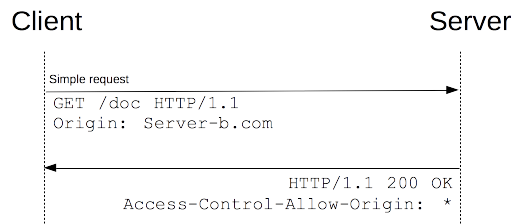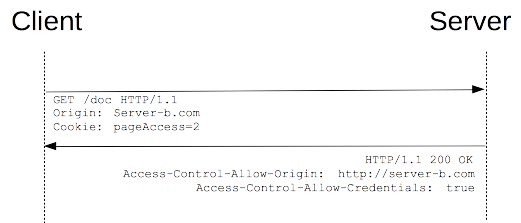CORS(Cross-Origin Resource Sharing)
웹 보안 정책 중 Same-Origin Policy는 한 출처(Origin)에서 로드된 문서나 스크립트가 다른 출처 자원과 상호작용하지 못하도록 제약한다. 언급한 출처(Origin)는 두 페이지의 프로토콜, 호스트, 포트가 같으면 동일 출처로 간주한다.
하지만 이러한 보안 정책으로 인해 타 사이트로부터 받아오는 리소스나 웹 폰트, CDN 등의 사용에 문제가 되고 있어 CORS(Cross-Origin Resource Sharing)이라는 추가 정책이 나오게 되었다.
CORS 요청
CORS 요청에는 Simple/Preflight, Credential/Non-Credential의 조합으로 총 4가지 요청이 존재한다. 브라우저가 요청 내용을 분석하여 4가지 방식 중 해당하는 방식으로 서버에 요청을 날리므로 프로그래머가 목적에 맞는 방식을 선택해 그 조건에 맞게 코딩해야 한다.
Simple Requests
몇몇 요청(Request)들은 CORS preflight를 트리거하지 않는다. MDN 자료와 티맥스 출처자료에서는 이를 두고 Simple Requests라고 구분하지만 CORS를 정의한 실제 Fetch 스펙에서는 Simple Requests라는 용어를 사용하지 않는다. CORS preflight를 트리거 하지 않는 요청(편의상 MDN에서 ‘simple requests’라고 명명했던)은 아래의 조건들을 모두 만족하는 요청을 가리킨다.
- GET/POST/HEAD 메서드만을 사용해야 한다.
- User Agent에 의해 자동으로 설정된 헤더, Fetch 스펙에서 “forbidden header name"이라고 정의된 헤더들을 제외하고 “CORS-safelisted request-header”라고 Fetch 스펙에 정의된 아래의 헤더만이 직접적으로 요청 안에 설정될 수 있다.
- Accept
- Accept-Language
- Content-Language
- Content-Type
- DPR
- Downlink
- Save-Data
- Viewport-Width
- Width
- Content-Type이 아래 중 하나여야 한다.
- application/x-www-form/urlencoded
- multipart/form-data
- text/plain (따로 지정하지 않을 시에 default)
- Request 안에
ReadableStream객체가 없어야 한다. - 요청 안에 있는
XMLHttpRequestUpload객체에 대한 이벤트 리스너가 없어야 한다. (해당 객체는 XMLHttpRequest.upload 프로퍼티를 이용해 접근 가능하다.)
이러한 Simple Request 방식에서 클라이언트는 서버로 요청을 한 번 보내고, 마찬가지로 서버도 회신을 한 번 보내는 것으로 요청에 대한 응답이 종료된다.
아래는 Simple requests를 사용하는 자바스크립트 예제이다. 아래 코드가 http://foo.example 서버로부터 제공되어 http://bar.other라는 외부 도메인으로부터 리소스를 받아오려 한다는 상황을 가정해보자.
var invocation = new XMLHttpRequest();
var url = 'http://bar.other/resources/public-data/';
function callOtherDomain() {
if(invocation) {
invocation.open('GET', url, true);
invocation.onreadystatechange = handler;
invocation.send();
}
}
위 코드를 통해 웹 브라우저가 서버로 Request를 보내고 서버로부터 Response를 받는 과정을 아래와 같이 간략하게 나타낼 수 있다.

이 때, 실제 Request와 Response가 어떤 식으로 오고 가는지 아래 텍스트를 보자. Request의 Origin, Response의 Access-Control-Allow-Origin 부분을 중심으로 살펴보자.
GET /resources/public-data/ HTTP/1.1
Host: bar.other
User-Agent: Mozilla/5.0 (Macintosh; U; Intel Mac OS X 10.5; en-US; rv:1.9.1b3pre) Gecko/20081130 Minefield/3.1b3pre
Accept: text/html,application/xhtml+xml,application/xml;q=0.9,*/*;q=0.8
Accept-Language: en-us,en;q=0.5
Accept-Encoding: gzip,deflate
Accept-Charset: ISO-8859-1,utf-8;q=0.7,*;q=0.7
Connection: keep-alive
Referer: http://foo.example/examples/access-control/simpleXSInvocation.html
Origin: http://foo.example
먼저, 위는 예제 코드가 서버로 보내는 Request를 나타내며 Origin 헤더부분은 컨텐츠가 http://foo.example로부터 오는 것이라고 서버에게 알리는 역할을 한다.
HTTP/1.1 200 OK
Date: Mon, 01 Dec 2008 00:23:53 GMT
Server: Apache/2.0.61
Access-Control-Allow-Origin: *
Keep-Alive: timeout=2, max=100
Connection: Keep-Alive
Transfer-Encoding: chunked
Content-Type: application/xml
위는 서버가 클라이언트로 보내는 Response를 나타내며, Access-Control-Allow-Origin: *은 모든 도메인의 cross-site 방식으로부터 액세스가 가능하다고 클라이언트에게 알리는 역할을 한다. 하지만 만약 이 헤더가
Access-Control-Allow-Origin: http://foo.example
처럼 왔다면 http://foo.example을 제외한 다른 도메인들에서는 cross-site 방식으로 해당 리소스에 접근할 수 없다는 것을 의미한다.
Preflighted Requests
Simple Requests와 다르게 “preflighted” requests(사전 전달 요청)는 먼저 OPTIONS 메서드를 이용하여 HTTP request를 먼저 보내 실제 요청이 보내기에 안전한지 확인한다. 아래 조건들 중 하나라도 만족하면 Preflighted Requests로 간주한다.
- Request가 아래 메서드를 사용한다.
- PUT
- DELETE
- CONNECT
- OPTIONS
- TRACE
- PATCH
Simple requests와 마찬가지로 User Agent의 자동 설정된 헤더를 제외하고, “CORS-safelisted request-header"를 포함한다.- Accept
- Accept-Language
- Content-Language
- Content-Type
- DPR
- Downlink
- Save-Data
- Viewport-Width
- Width
- Content-Type 헤더 값이 아래를 제외한 다른 값인 경우
- application/x-www-form-url
- multipart/form-data
- text/plain
- Request 안에 있는
XMLHttpRequestUpload객체에 한 개 이상의 이벤트 리스너가 등록된 경우 ReadableStream이 Request 안에서 사용된 경우
아래는 preflighted 요청을 위한 자바스크립트 예제이다.
var invocation = new XMLHttpRequest();
var url = 'http://bar.other/resources/post-here/';
var body = '<?xml version="1.0"?><person><name>Arun</name></person>';
function callOtherDomain(){
if(invocation)
{
invocation.open('POST', url, true);
invocation.setRequestHeader('X-PINGOTHER', 'pingpong');
invocation.setRequestHeader('Content-Type', 'application/xml');
invocation.onreadystatechange = handler;
invocation.send(body);
}
}
위 예제 코드에서는 XML body를 보내기 위해 POST 방식을 사용하고 X-PINGOTHER: pingpong이라는 customized request 헤더를 사용했다. 또한, application/xml Content-Type을 사용함으로써 위에서 명시된 3가지 Content-Type 외에 해당하여 해당 request가 preflighted 타입이라는 것을 알 수 있다.
이제, 이 preflighted request가 서버로 보내질 때 어떤 식으로 요청과 응답이 오고가는지 아래 그림을 통해 개괄적으로 살펴보자.

위 그림에서 주의해야할 것은 아래의 실제 REQUEST/REPONSE 코드에서 보겠지만 실제 POST request 안에는 Access-Control-Request-* 헤더가 없다는 점이다. 해당 헤더들은 모두 OPTIONS request에서만 필요하다. 또한, preflighted request의 경우 메인 Request를 보내기 전에 Preflighted Request를 한번 더 보낸다는 점이 주의하자.
아래는 위 다이어그램에 대한 실제 Request & Response 내용이다.
OPTIONS /resources/post-here/ HTTP/1.1
Host: bar.other
User-Agent: Mozilla/5.0 (Macintosh; U; Intel Mac OS X 10.5; en-US; rv:1.9.1b3pre) Gecko/20081130 Minefield/3.1b3pre
Accept: text/html,application/xhtml+xml,application/xml;q=0.9,*/*;q=0.8
Accept-Language: en-us,en;q=0.5
Accept-Encoding: gzip,deflate
Accept-Charset: ISO-8859-1,utf-8;q=0.7,*;q=0.7
Connection: keep-alive
Origin: http://foo.example
Access-Control-Request-Method: POST
Access-Control-Request-Headers: X-PINGOTHER, Content-Type
HTTP/1.1 200 OK
Date: Mon, 01 Dec 2008 01:15:39 GMT
Server: Apache/2.0.61 (Unix)
Access-Control-Allow-Origin: http://foo.example
Access-Control-Allow-Methods: POST, GET
Access-Control-Allow-Headers: X-PINGOTHER, Content-Type
Access-Control-Max-Age: 86400
Vary: Accept-Encoding, Origin
Content-Encoding: gzip
Content-Length: 0
Keep-Alive: timeout=2, max=100
Connection: Keep-Alive
Content-Type: text/plain
먼저, preflighted request와 그 응답에 대해 살펴보자. Access-Control-Request-Method 해더는 서버에게 실제 Request가 보내졌을 때 해당 Request의 메서드와 X-PINGOTHER, Content-Type 등의 custom header들을 함께 전송할 것이라고 미리 알린다. 서버는 클라이언트로부터 이러한 정보를 미리 preflighted request를 통해 전달받고 실제 request를 받을 것인지를 결정한 뒤 알려준다. 위에 나타난 Reponse 코드 중 유심해야할 부분은 다음과 같다.
Access-Control-Allow-Origin: http://foo.example
Access-Control-Allow-Methods: POST, GET
Access-Control-Allow-Headers: X-PINGOTHER, Content-Type
Access-Control-Max-Age: 86400
서버는 preflighted request에 대한 응답을 통해 클라이언트로 사용 가능한 메서드와 헤더, 그리고 해당 리소스 접근을 위해 허용된 origin을 http://foo.example로 제한하여 보내주고 있다. 마지막으로 Access-Control-Max-Age는 해당 reponse가 또다른 preflight request를 보내지 않고 얼마 동안 캐시되어 있는지를 클라이언트에게 알려주는 역할을 한다. 여기서 86400은 86400초를 나타내어 24시간동안 cached response가 유효하다고 알린다.
POST /resources/post-here/ HTTP/1.1
Host: bar.other
User-Agent: Mozilla/5.0 (Macintosh; U; Intel Mac OS X 10.5; en-US; rv:1.9.1b3pre) Gecko/20081130 Minefield/3.1b3pre
Accept: text/html,application/xhtml+xml,application/xml;q=0.9,*/*;q=0.8
Accept-Language: en-us,en;q=0.5
Accept-Encoding: gzip,deflate
Accept-Charset: ISO-8859-1,utf-8;q=0.7,*;q=0.7
Connection: keep-alive
X-PINGOTHER: pingpong
Content-Type: text/xml; charset=UTF-8
Referer: http://foo.example/examples/preflightInvocation.html
Content-Length: 55
Origin: http://foo.example
Pragma: no-cache
Cache-Control: no-cache
<?xml version="1.0"?><person><name>Arun</name></person>
HTTP/1.1 200 OK
Date: Mon, 01 Dec 2008 01:15:40 GMT
Server: Apache/2.0.61 (Unix)
Access-Control-Allow-Origin: http://foo.example
Vary: Accept-Encoding, Origin
Content-Encoding: gzip
Content-Length: 235
Keep-Alive: timeout=2, max=99
Connection: Keep-Alive
Content-Type: text/plain
[Some GZIP'd payload]
Requests with credentials
마지막으로 Credential, Non-Credential을 구분할 CORS Request 종류에 대해 기술한다. 이 “credentialed” requests는 HTTP Cookie와 HTTP Authentication information의 취약점에 대비하여 만들어진 request 타입이다. 기본으로 웹 브라우저는 cross-site XMLHttpRequest와 Fetch invocation에서 credential을 보내지 않는다.
아래 코드를 예로 들어보자. http://bar.other/로부터 받은 컨텐츠가 쿠키를 설정하는 리소스라고 가정하고, 아래 자바스크립트 코드가 http://foo.example내에서 동작하는 코드라고 생각하자.
var invocation = new XMLHttpRequest();
var url = 'http://bar.other/resources/credentialed-content/';
function callOtherDomain(){
if(invocation) {
invocation.open('GET', url, true);
invocation.withCredentials = true;
invocation.onreadystatechange = handler;
invocation.send();
}
}

위처럼 새로 가져올 컨텐츠에서 캐시를 설정하는 등의 행위를 할 때 반드시 withCredentials를 설정해줘야 하며, 해당 헤더가 설정되었다면 웹 브라우저는 서버로부터 받은 response 안에 Access-Control-Allow-Credentials: true가 없는 경우는 모두 거절해버린다.